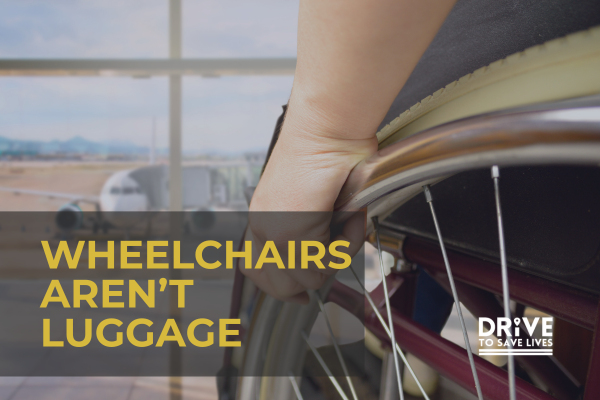This featured blog for the month of June was written by one of the Drive to Save Lives prevention speakers, Steve Emt.
I’m a very lucky man. Half of my life I get to travel the world and compete for Team USA. The other half, I get to travel the country and speak to people of all ages about my life and what I’ve learned. I cherish what I do and look forward to every trip I take—but let’s be real: traveling on an airplane in a wheelchair comes with some serious challenges.
Many people have no idea what the process looks like for someone like me who can’t walk and relies on a wheelchair. It’s not just wheeling down the aisle, buckling up, and taking off. Far from it.
Since airplane aisles are too narrow for any standard wheelchair, we use what’s called an “aisle chair.” When I arrive at the gate, I have to ask for assistance. That means waiting for a contracted third-party company to bring the aisle chair and help me transfer into it. The chair is small, tight, and requires straps around my legs and shoulders. Then I’m rolled backward down the narrow aisle to my seat. After transferring into the airplane seat, my regular wheelchair is taken and (hopefully) loaded into the cargo area.
“My wheelchair isn’t luggage. It’s my independence. My freedom. Treat it with the care you’d give your own legs.” – Steve Emt
When we land, the whole process happens in reverse. Sounds simple enough, right?
Well… not exactly.
Here’s what actually happens far too often:
The aisle chair staff don’t work for the airlines. They’re contracted by the airport. That means I have to arrive at the gate early, alert the airline, and hope the request actually gets processed. Even if the company shows up, they often send just one person to help me. This is a two-person job—period. I’m lucky that I’m mobile enough to handle it with minimal support, but not everyone is.
And then there’s my wheelchair. Every time I say goodbye to it before boarding, I’m holding my breath. I’ve had it show up late. I’ve had it not show up at all. I’ve watched it get tossed like baggage from the airplane window—literally falling off the conveyor belt. These chairs aren’t luggage. They’re my legs. My independence. My freedom.
And after landing, I’m often left waiting on the plane. Sometimes for 10 minutes. Sometimes for 90. I once missed a connection in Chicago because no one came to assist me off the plane. I’ve sat in empty aircrafts while crews sweep around me, unsure if I’ve been forgotten or if someone’s finally on their way.
And here’s the thing—we can and must do better.
The Americans with Disabilities Act (ADA) was signed into law in 1990 to prohibit discrimination based on disability—including in transportation. Under the Air Carrier Access Act (ACAA), airlines are required to provide accessible services and handle mobility devices with care. But let’s be honest: policies are only as good as the people and systems that put them into practice.
This isn’t just about my story. It’s about accountability. Dignity. Respect.
If you’re a business leader, HR professional, DEI manager, or someone working in travel, hospitality, or corporate training—here’s what I want you to know:
- People with disabilities travel. We work. We compete. We speak on stages. We represent brands.
- Inclusion isn’t just about ramps or checkboxes. It’s about training, empathy, and systems that serve human beings with respect.
- You don’t have to break the law to do the right thing—but the law does require you to do better.
“We don’t need sympathy. We need systems that work—and people who care enough to fix what’s broken.”– Steve Emt
So now what?
I share my story because I want to raise awareness—but also because I believe in action. Education and empathy lead to better systems. That’s why I speak—to help companies, schools, and organizations see the gaps and build bridges.
If you’re ready to start a real conversation about accessibility, inclusion, and what it actually means to treat people with disabilities with dignity, I’d love to work with your team. Not just to inspire—but to equip and empower.
Let’s stop treating wheelchairs like luggage.
Let’s start treating people like people.

